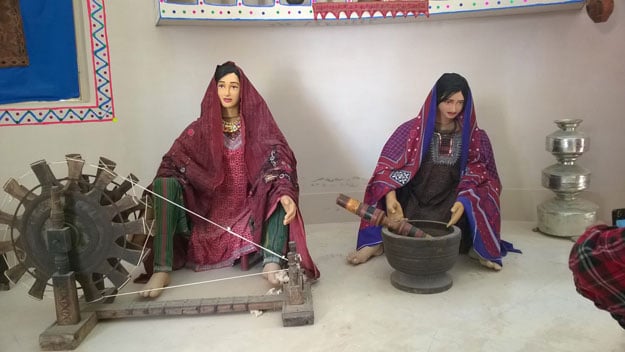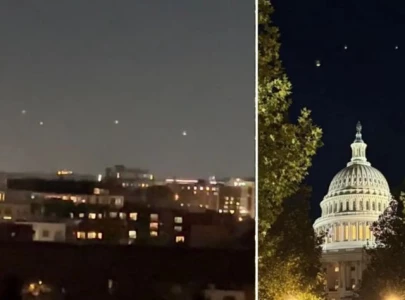
 PHOTO: Ferya Ilyas/EXPRESS
PHOTO: Ferya Ilyas/EXPRESSHundreds of years later, from the well in Bhalwa village of Nagarparkar still emanates the spirit of a woman so chaste that she denied a life of royalty amid jewels and gifts, choosing to return to her betrothed instead. This tale of piety and unrequited love commonly attributed to poet Shah Abdul Latif Bhittai is one of the seven popular tragic romances of Sindh and also appeared in Bhittai’s journal Shah Jo Risalo. Like the tale, Marvi’s well too has survived through the years.
 PHOTO: Ferya Ilyas/EXPRESS
PHOTO: Ferya Ilyas/EXPRESSThe place around the 150-feet well is now part of the Marvi Cultural Complex. The officer in charge, Altaf Rajper, says the fully-functional complex was completed in 2013 and is open to public. He adds it can house a visiting family of seven.
 PHOTO: Ferya Ilyas/EXPRESS
PHOTO: Ferya Ilyas/EXPRESS"Many people visit the place throughout the year, but especially during the monsoon season. There is a huge turnout in August. A large number of tourists visit from far and wide. [Marvi’s] devotees come here to pay homage to the honourable and resilient girl that she was," says Rajper. "The well is blessed. I have heard tales of people coming and wishing upon the well. People also drink its water believing it will cure them of their illnesses."
 PHOTO: Ferya Ilyas/EXPRESS
PHOTO: Ferya Ilyas/EXPRESSTharparkar district is the largest desert area of Pakistan, known for brutal droughts that have claimed hundreds of lives in recent years, particularly of the vulnerably young and old. But Rajper insists even when every well in the area runs dry, Marvi’s well doesn’t. "During the cold winters, the water from Marvi’s well is steaming hot. In the summer, the opposite happens and the water turns cold. Such are the mysteries of this well," he claims.
 PHOTO: Ferya Ilyas/EXPRESS
PHOTO: Ferya Ilyas/EXPRESSRajper is clearly enamoured by Marvi’s legend. "She was a pure, untouched woman. But after Umar dropped her back to this well, she was eyed with suspicion. So much so, that her fiancé Khet told her, ‘You are like a watermelon whose pulp has been eaten and tasted, and it can’t do away the thirst’. Hearing this, it is said she was heartbroken," narrates Rajper.
 PHOTO: Ferya Ilyas/EXPRESS
PHOTO: Ferya Ilyas/EXPRESSAnd to tug at the visitors’ heartstrings are four musicians seated next to the well. Faqir Ali Dino, Faqir Abdullah, alghoza player Faqir Khashkeli and dhol player Juma Khan belt out kalaams of Shah Abdul Bhittai much to the delight of onlookers.
 PHOTO: Ferya Ilyas/EXPRESS
PHOTO: Ferya Ilyas/EXPRESSMusic has always been an integral part of Tharparkar’s landscape. Till sometime ago, a mela was also organised for the entertainment of locals and tourists. Though the carnival has not taken place in some time now, Rajper hopes it will soon be revived.
Reviving folklore: Mirza, Sahibaan spellbound audience at PNCA
Culture and Tourism Director Aijaz Ahmed Sheikh confirms they are working to revive the mela. "We are making all out efforts to hold it by the mid or end of February,” he says. But remembering all the lives lost in Tharparkar due to the recent droughts, his tone turns sombre. "At the end of the day, we can’t be celebrating when things are so rough for the children of Tharparkar," he adds as a caveat.
For the love of land: A history of Sindh’s sons
Still, Nagarparkar is not all tragedy. Much like the hearts of those who wish upon Marvi’s well, there is hope within the dusty dunes. Hope that like Marvi, better days will return.
The writer is a staff correspondent who visited Tharparkar as part of a trip organised by Pakistan Council of Media Women.

1732868310-0/BeFunk_§_]__-(72)1732868310-0.jpg)
1732869272-0/diddy-(47)1732869272-0-165x106.webp)


1732861143-0/Untitled-design-(73)1732861143-0-270x192.webp)











COMMENTS
Comments are moderated and generally will be posted if they are on-topic and not abusive.
For more information, please see our Comments FAQ